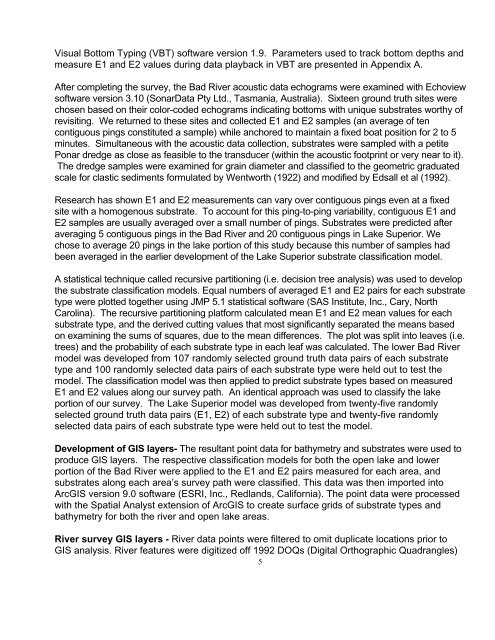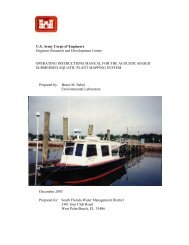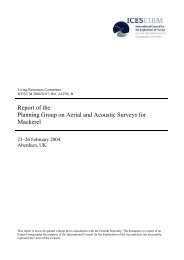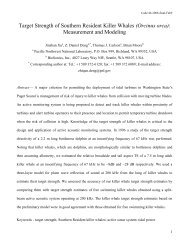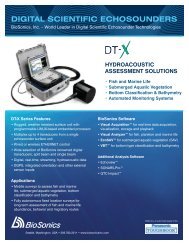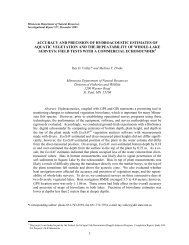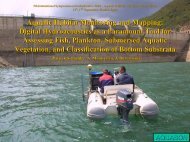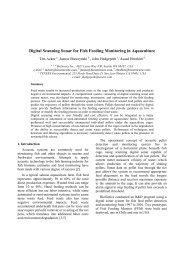Mapping Potential Lake Sturgeon Habitat in the ... - BioSonics, Inc
Mapping Potential Lake Sturgeon Habitat in the ... - BioSonics, Inc
Mapping Potential Lake Sturgeon Habitat in the ... - BioSonics, Inc
Create successful ePaper yourself
Turn your PDF publications into a flip-book with our unique Google optimized e-Paper software.
Visual Bottom Typ<strong>in</strong>g (VBT) software version 1.9. Parameters used to track bottom depths andmeasure E1 and E2 values dur<strong>in</strong>g data playback <strong>in</strong> VBT are presented <strong>in</strong> Appendix A.After complet<strong>in</strong>g <strong>the</strong> survey, <strong>the</strong> Bad River acoustic data echograms were exam<strong>in</strong>ed with Echoviewsoftware version 3.10 (SonarData Pty Ltd., Tasmania, Australia). Sixteen ground truth sites werechosen based on <strong>the</strong>ir color-coded echograms <strong>in</strong>dicat<strong>in</strong>g bottoms with unique substrates worthy ofrevisit<strong>in</strong>g. We returned to <strong>the</strong>se sites and collected E1 and E2 samples (an average of tencontiguous p<strong>in</strong>gs constituted a sample) while anchored to ma<strong>in</strong>ta<strong>in</strong> a fixed boat position for 2 to 5m<strong>in</strong>utes. Simultaneous with <strong>the</strong> acoustic data collection, substrates were sampled with a petitePonar dredge as close as feasible to <strong>the</strong> transducer (with<strong>in</strong> <strong>the</strong> acoustic footpr<strong>in</strong>t or very near to it).The dredge samples were exam<strong>in</strong>ed for gra<strong>in</strong> diameter and classified to <strong>the</strong> geometric graduatedscale for clastic sediments formulated by Wentworth (1922) and modified by Edsall et al (1992).Research has shown E1 and E2 measurements can vary over contiguous p<strong>in</strong>gs even at a fixedsite with a homogenous substrate. To account for this p<strong>in</strong>g-to-p<strong>in</strong>g variability, contiguous E1 andE2 samples are usually averaged over a small number of p<strong>in</strong>gs. Substrates were predicted afteraverag<strong>in</strong>g 5 contiguous p<strong>in</strong>gs <strong>in</strong> <strong>the</strong> Bad River and 20 contiguous p<strong>in</strong>gs <strong>in</strong> <strong>Lake</strong> Superior. Wechose to average 20 p<strong>in</strong>gs <strong>in</strong> <strong>the</strong> lake portion of this study because this number of samples hadbeen averaged <strong>in</strong> <strong>the</strong> earlier development of <strong>the</strong> <strong>Lake</strong> Superior substrate classification model.A statistical technique called recursive partition<strong>in</strong>g (i.e. decision tree analysis) was used to develop<strong>the</strong> substrate classification models. Equal numbers of averaged E1 and E2 pairs for each substratetype were plotted toge<strong>the</strong>r us<strong>in</strong>g JMP 5.1 statistical software (SAS Institute, <strong>Inc</strong>., Cary, NorthCarol<strong>in</strong>a). The recursive partition<strong>in</strong>g platform calculated mean E1 and E2 mean values for eachsubstrate type, and <strong>the</strong> derived cutt<strong>in</strong>g values that most significantly separated <strong>the</strong> means basedon exam<strong>in</strong><strong>in</strong>g <strong>the</strong> sums of squares, due to <strong>the</strong> mean differences. The plot was split <strong>in</strong>to leaves (i.e.trees) and <strong>the</strong> probability of each substrate type <strong>in</strong> each leaf was calculated. The lower Bad Rivermodel was developed from 107 randomly selected ground truth data pairs of each substratetype and 100 randomly selected data pairs of each substrate type were held out to test <strong>the</strong>model. The classification model was <strong>the</strong>n applied to predict substrate types based on measuredE1 and E2 values along our survey path. An identical approach was used to classify <strong>the</strong> lakeportion of our survey. The <strong>Lake</strong> Superior model was developed from twenty-five randomlyselected ground truth data pairs (E1, E2) of each substrate type and twenty-five randomlyselected data pairs of each substrate type were held out to test <strong>the</strong> model.Development of GIS layers- The resultant po<strong>in</strong>t data for bathymetry and substrates were used toproduce GIS layers. The respective classification models for both <strong>the</strong> open lake and lowerportion of <strong>the</strong> Bad River were applied to <strong>the</strong> E1 and E2 pairs measured for each area, andsubstrates along each area’s survey path were classified. This data was <strong>the</strong>n imported <strong>in</strong>toArcGIS version 9.0 software (ESRI, <strong>Inc</strong>., Redlands, California). The po<strong>in</strong>t data were processedwith <strong>the</strong> Spatial Analyst extension of ArcGIS to create surface grids of substrate types andbathymetry for both <strong>the</strong> river and open lake areas.River survey GIS layers - River data po<strong>in</strong>ts were filtered to omit duplicate locations prior toGIS analysis. River features were digitized off 1992 DOQs (Digital Orthographic Quadrangles)5


